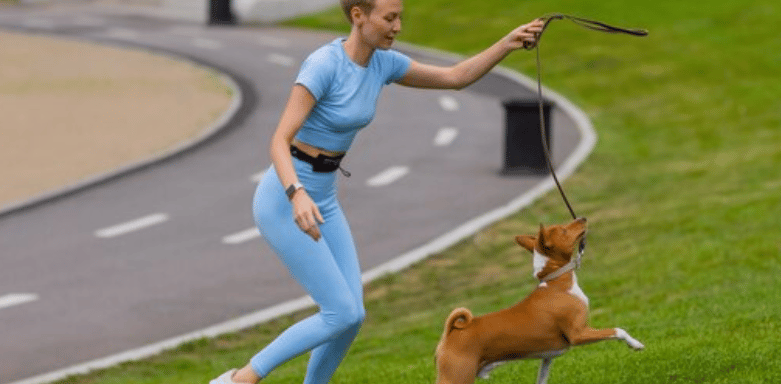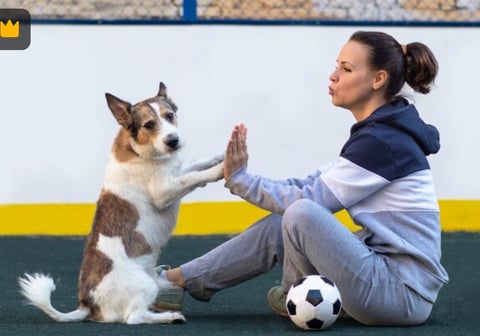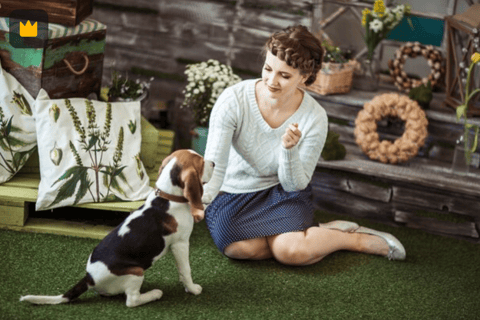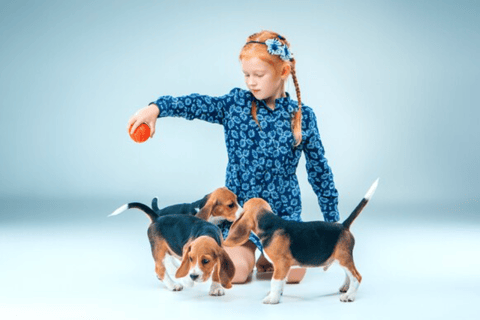
Puppy Training Schedule by Age: A Comprehensive Guide to Training Your Puppy at Every Age
Welcome to the wonderful journey of raising a puppy! This guide is packed with tips, insights, and advice to help you and your furry friend lay the foundations for a lifetime of happiness together. From the first weeks to beyond the first year, we'll walk through each stage of your puppy's development, focusing on training techniques that suit their age and learning capacity. Let's dive in and discover how patience, persistence, and understanding can nurture an unbreakable bond between you and your pup.
FAMILY
Grace Isabella
4/27/20245 min read
I. Introduction
Raising a puppy is much like embarking on an adventure where both of you learn and grow together. It's an investment of time, patience, and love, but the rewards are immeasurable. By understanding the stages of puppy development and dedicating yourself to consistent training, you're setting the stage for a well-behaved, happy dog.
Check Out Brain Training for Dogs Official Website Here
II. Understanding Puppy Development Stages
Puppies grow and learn at an astonishing rate. Each stage of their development is an opportunity to instill valuable behaviors and habits. Recognizing and respecting these stages helps tailor your training approach to be both effective and enjoyable.
III. Importance of Training Early and Consistently
The early weeks and months in a puppy’s life are critical for training. Early and consistent training establishes a routine, builds a strong relationship, and helps prevent problematic behaviors before they start.
Go to the Official Brain Training for Dogs Website Here
IV. Setting Expectations: Patience and Persistence
Training a puppy requires a blend of patience and persistence. Your puppy will have good days and challenging ones. Setting realistic expectations about the process helps you stay patient and positive.
1. Starting Off: Training Your 8-Week Old Puppy
House Training Basics: Establishing a Routine, Crate Training, and Night-Time Tips
Start with establishing a regular bathroom schedule. Take your puppy outside frequently, especially after meals and naps. Crate training can also be a beneficial tool, providing your puppy with a safe space and helping with house training. Remember, night-time might require extra patience as your puppy learns to hold it through the night.
Socialization: Importance of Early Exposure, Safe Socialization Methods
Introducing your puppy to a variety of people, animals, and environments early on is crucial. This exposure helps them become well-adjusted and social. However, it's important to ensure all interactions are safe and positive.
Basic Commands: Sit, Stay, and Name Recognition
Focus on simple commands such as "sit," "stay," and recognizing their name. Short, frequent training sessions work best, using treats and praise to reinforce good behavior.
2. Building Skills: Training Your 3-4 Month Old Puppy
Continued Socialization: Expanding the Social Circle, Introducing New Environments
Continue to introduce new experiences, keeping socialization positive and controlled. This age is perfect for puppy classes, which can reinforce social skills and obedience.
Basic Obedience: Reinforcing Commands, Beginning Leash Training
Reinforce the basic commands learned earlier and begin leash training. This sets the stage for pleasant walks, teaching your puppy to follow your lead without pulling.
Behavior Management: Biting, Barking, and Jumping
Address behaviors like biting, barking, and jumping early. Consistent redirection to acceptable behaviors and plenty of chew toys for teething can help manage biting.
3. The Formative Stage: Training Your 5-6 Month Old Puppy
Advanced Commands: Down, Come, Leave It
Build on basic commands by introducing more complex ones like "down," "come," and "leave it." These commands enhance your control and your puppy's safety.
Leash and Walking Etiquette: Mastering the Walk, Heel Command
Work on leash skills, teaching your puppy to walk politely by your side. The "heel" command helps manage pulling and ensures a pleasant walk for both of you.
Preventing Bad Habits: Begging, Counter Surfing, and Preventing Resource Guarding
This is the time to nip any emerging bad habits in the bud. Teach polite behavior around food and establish clear boundaries to prevent counter surfing and begging.
Brain Training for Dogs Website: Click to Access
4. Adolescence: Training Your 6-12 Month Old Puppy
Reinforcement and Consistency: Maintaining Obedience Through the 'Teen' Phase
Your puppy may test boundaries as they enter adolescence. Continue reinforcing training with consistency and patience. This maintains the progress you’ve made together.
Distraction Training: Listening and Responding in Different Environments
Introduce training in various environments to teach your puppy to listen and respond, even with distractions. This enhances their focus and obedience.
Preparing for Adulthood: Settling Into a Routine, Advanced Tricks and Tasks
Establish a daily routine that includes time for exercise, play, and training. You can also start teaching more advanced tricks and tasks, based on your puppy's breed and interests.
5. Beyond the First Year: Continuing Education for Your Growing Dog
Ongoing Training Opportunities: Agility, Therapy Work, Advanced Obedience
Exploring activities like agility, therapy work, or advanced obedience can be rewarding for both you and your dog. These activities keep their mind sharp and strengthen your bond.
Behavioral Adjustments: Dealing With Aggression, Fear, and Anxiety
As your dog matures, be mindful of any behavioral changes. Address aggression, fear, and anxiety early, seeking professional help if needed.
Maintaining Social Skills: Regular Socialization, Playdates, and Park Etiquette
Continue to prioritize socialization. Regular playdates and park visits encourage good social behavior and provide valuable exercise and mental stimulation.
Learn More About Brain Training for Dogs on Their Official Website Here
Summary
Training your puppy at every age sets the foundation for a lifetime of happiness and companionship. Remember, each puppy is unique, and training is not a one-size-fits-all process. Patience, consistency, and understanding will guide you through this rewarding journey.
FAQs
How long should daily training sessions last for a puppy?
Keep training sessions short and sweet. For young puppies, aim for 5-10 minutes at a time, several times a day.
Is it ever too late to start training a puppy?
It's never too late to start! While early training can be easier, dogs of all ages can learn new behaviors and habits.
What do I do if my puppy is not responding to training?
If your puppy struggles, take a step back and simplify. Ensure the environment is conducive to learning, with minimal distractions. Patience and consistency are key.
How do I find the right balance between discipline and reward?
Use positive reinforcement to encourage good behavior. Corrective actions should be gentle guidance rather than harsh discipline. Celebrate success with treats and praise.
Can training help with my puppy's separation anxiety?
Yes, training can help manage separation anxiety. Gradually acclimating your puppy to being alone, along with consistent routines, can provide comfort and reduce anxiety
Connect
info@graciebusiness.com










